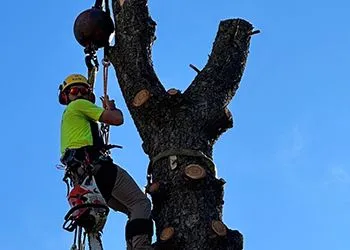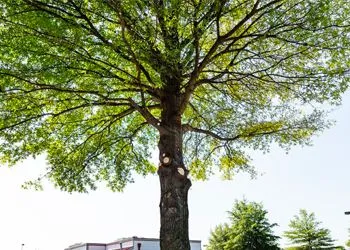5 Indications that Your Tree Is a Safety Hazard

Healthy trees provide beauty and environmental benefits, but when they become compromised, they can pose significant risks. A hazardous tree can cause property damage and serious injuries. At Abundant Tree Care Services, our local arborists can identify and safely remove dangerous trees. Here are five signs that your tree might be a safety hazard.
Cracks or Splits in the Trunk
Cracks and splits in the trunk can weaken a tree’s structural integrity, making it more likely to fall. Deep fissures or multiple cracks may indicate internal decay or previous storm damage. If a tree has a significant crack, it may be unstable and prone to collapse. The arborist can assess the extent of the damage and recommend the best course of action.
Leaning with Exposed Roots
A tree that is leaning significantly, particularly if it has recently changed position, is a major red flag. Leaning trees often have compromised root systems, especially if you notice exposed or damaged roots near the base. Soil erosion, storms, or root disease can contribute to instability. If your tree has started tilting and the roots appear disrupted, it may be at risk of toppling over.
Dead/Dying Branches
If you notice large branches that are dead or dying, your tree may be in trouble. Dead limbs can break off unexpectedly, especially during storms or high winds, creating a serious hazard for people, vehicles, and structures nearby. If your tree has a significant number of dead branches, it may be time for professional evaluation to determine if pruning or removal is necessary.
Signs of Fungal Growth or Decay
The presence of fungal growth at the base of a tree can indicate internal decay. Fungi feed on rotting wood, which means the tree’s internal structure may be compromised. Hollow or soft spots in the trunk can also suggest decay, reducing the tree’s ability to withstand storms and high winds. A tree with significant decay should be evaluated to determine whether it poses a risk.
Nearby Structures Are at Risk
Even if a tree appears healthy, its location can make it a hazard. Trees that are too close to buildings or power lines can create safety issues. Branches that extend over roofs or utility lines can break off and cause damage. If your tree is encroaching on a structure or utility line, professional trimming or removal may be necessary.
Tree Removal in De Soto, IL
For expert arborist services in De Soto, Carbondale, and Southern Illinois, contact Abundant Tree Care Services at
618-227-2881. Feel free to give us a call to ask for an estimate!




